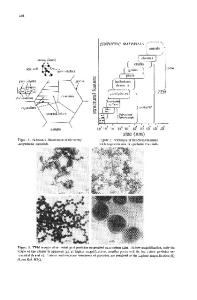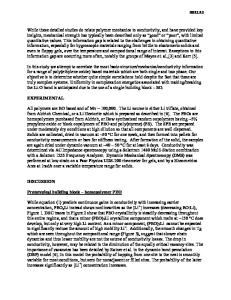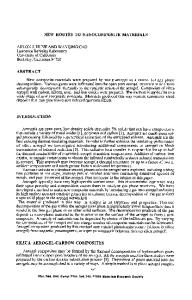Hierarchically Ordered Multi-Component Block Copolymer/Particle Nanocomposite Materials
- PDF / 1,825,123 Bytes
- 11 Pages / 612 x 792 pts (letter) Page_size
- 60 Downloads / 295 Views
L9.1.1
Hierarchically Ordered Multi-Component Block Copolymer/Particle Nanocomposite Materials M. R. Bockstaller, E. L. Thomas* Dept. of Materials Science and Engineering, and Institute of Soldier Nanotechnologies, Massachusetts Institute of Technology, 77 Massachusetts Ave, Cambridge, MA 02139, USA
ABSTRACT This contribution reviews the structure formation processes that are observed in binary diblock copolymer/particle and ternary diblock copolymer/particle1/particle2 mixtures. The particle core size, the polymer domain spacing as well as the particle surface chemistry are shown to determine three distinct morphological types in particle/block copolymer composites, which is the preferential layer homogeneous distribution, the interfacial segregation and center alignment of the nanocrystals within one polymer domain. The different microstructural environments of the sequestered component that are implied by the respective particle distribution result in distinctively different optical properties of the composite and have important consequences for the prospects of metal nanocrystal/block copolymer composites as a platform for photonic crystal engineering. A detailed comparison between morphological studies and theoretical predictions will be presented that aims to better understand and control morphologies of structured cluster matter and its relation to the respective optical and mechanical properties of new microstructured composite materials.
INTRODUCTION Self–assembly of block copolymers provides an elegant bottom-up approach for fabricating photonic materials for the optical region since they organize into periodic 1D (lamellar), 2D (cylindrical) or 3D (cubic) morphologies with characteristic length scales that can be tailored to be of the order of the wavelength of light [1,2,3]. Self–assembly becomes particularly versatile when inorganic nanoparticles are added to the polymer material thereby combining the advantageous processing and mechanical properties of the polymer matrix with the unique optical and magnetic properties of nanoparticles. Recently we demonstrated that by preferential sequestering of polymer-coated gold nanocrystals within microphase separated diblock copolymers, metallodielectric photonic materials can be obtained that exhibit high rejection levels for incident light due to the increased refractive index difference between the adjacent domains [4]. Technological relevance of these materials is intimately linked to a fundamental understanding of the relationship between the structural characteristics at the nano– and mesoscale level and the optical properties of the nanocomposite so as to afford reliable prediction of the photonic properties in order to tailor the materials for various applications. The aim of this contribution is twofold: First, we identify different morphological types of particle distribution within lamellar block copolymer microstructures and discuss
L9.1.2
parameters that allow the control of the structure. Second, the implications of the particle distribution w
Data Loading...











